Reproduction
Reproduction
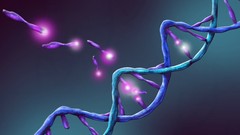
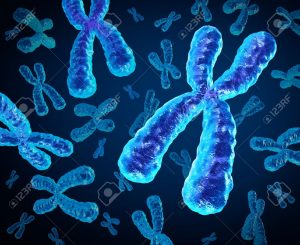
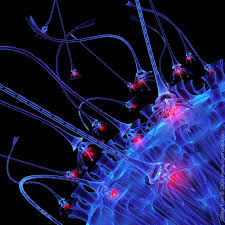
Reproduction is a process by which organisms replicate themselves. The act of reproducing or the condition or process of being reproduced. Reproduction is the sexual or asexual process by which organisms generate new individuals of the same kind, procreation or breeding.
Or,
Reproduction is the biological process by which new individual organisms – “offspring” – are produced from their “parents”. Reproduction is a fundamental feature of all known life; each individual organism exists as the result of reproduction.
Or,
Reproduction refers to the production of offspring by organized bodies. The offspring is produced as a new individual organism from the parent(s). It is one of the fundamental attributes of a living thing. Reproduction is a demonstration of the ability of an organism to produce a new organism referred to as an offspring.
Reproduction is the process by which cells and organisms produce other cells and organisms of the same kind. Cell reproduction usually involves division of a cell into two identical parts by means of mitosis or into four different parts by meiosis.
There are two forms or modes of reproduction: Asexual and Sexual.

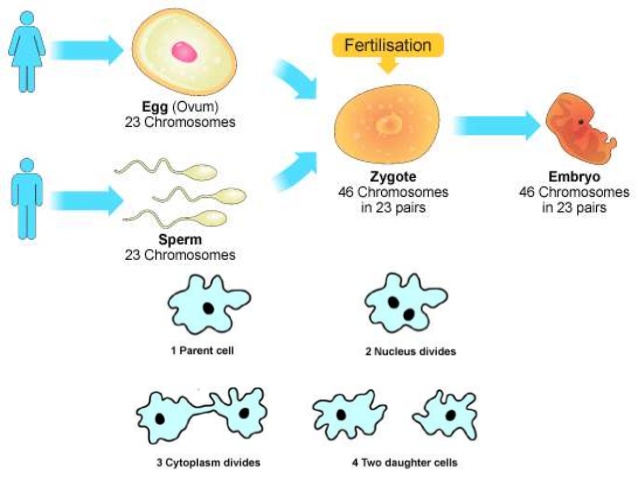
Asexual reproduction Reproduction in which offspring are produced by a single parent, without the union of reproductive cells, is called asexual reproduction. Asexual reproduction is not limited to single-celled organisms. Cloning of an organism is a form of asexual reproduction. By asexual reproduction, an organism creates a genetically similar or identical copy of itself. Bacteria divide asexually via binary fission, viruses take control of host cells to produce more viruses, Hydras (invertebrates of the order Hydroidea) and yeasts are able to reproduce by budding. These organisms often do not possess different sexes, and they are capable of “splitting” themselves into two or more copies of themselves. Most plants have the ability to reproduce asexually.
Sexual reproduction The reproduction of organisms by the union of male and female reproductive cells (gametes) is called sexual reproduction. Most multicellular animals reproduce sexually. Sexual reproduction typically requires the sexual interaction of two specialized organisms, called gametes, which contain half the number of chromosomes of normal cells and are created by meiosis, with typically a male fertilizing a female of the same species to create a fertilized zygote. This produces offspring organisms whose genetic characteristics are derived from those of the two parental organisms. Most animals (including humans) and plants reproduce sexually.
Many plants and fungi are capable of reproducing both sexually and asexually, as are some animals, such as sponges.
Allogamy Allogamy is the fertilization of the combination of gametes from two parents, generally the ovum from one individual with the spermatozoa of another. (In isogamous species, the two gametes will not be defined as either sperm or ovum.)
Autogamy Self-fertilization, also known as autogamy, occurs in hermaphroditic organisms where the two gametes fused in fertilization come from the same individual, e.g., many vascular plants, some foraminiferans, some ciliates.
Mitosis and Meiosis
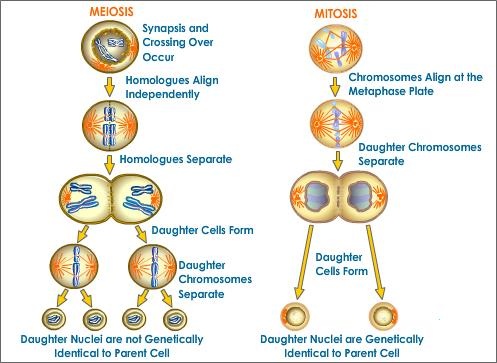
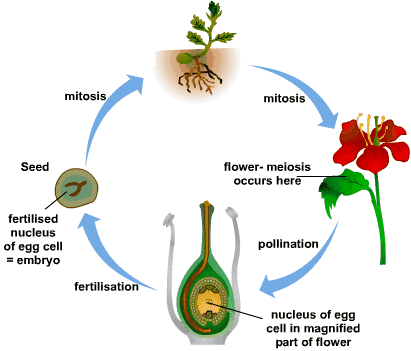
Mitosis and Meiosis are types of cell division. Mitosis occurs in somatic cells, while meiosis occurs in gametes. Mitosis The resultant number of cells in mitosis is twice the number of original cells. The number of chromosomes in the offspring cells is the same as that of the parent cell.
Meiosis The resultant number of cells is four times the number of original cells. This results in cells with half the number of chromosomes present in the parent cell. A diploid cell duplicates itself, then undergoes two divisions (tetraploid to diploid to haploid), in the process forming four haploid cells. This process occurs in two phases, meiosis I and meiosis II.
Reproductive System
The reproductive system is a collection of internal and external organs — in both males and females — that work together for the purpose of procreating. Or, The reproductive system or genital system is a system of sex organs within an organism which work together for the purpose of sexual reproduction.
The Human reproductive system
Human reproductive system, organ system by which humans reproduce and bear live offspring. Provided all organs are present, normally constructed, and functioning properly, the essential features of human reproduction are:
- liberation of an ovum, or egg, at a specific time in the reproductive cycle.
- Internal fertilization of the ovum by spermatozoa, or sperm cells.
- Transport of the fertilized ovum to the uterus, or womb.
- Implantation of the blastocyst, the early embryo developed from the fertilized ovum, in the wall of the uterus.
- Formation of a placenta and maintenance of the unborn child during the entire period of gestation.
- Birth of the child and expulsion of the placenta. and
- Suckling and care of the child, with an eventual return of the maternal organs to virtually their original state.

The human reproductive system usually involves internal fertilization by sexual intercourse. During this process, the male inserts his penis into the female’s vagina and ejaculates semen, which contains sperm. A small portion of the sperm pass through the cervix into the uterus, and then into the fallopian tubes for fertilization of the ovum. Only one sperm is required to fertilize the ovum. Upon successful fertilization, the fertilized ovum, or zygote, travels out of the fallopian tube and into the uterus, where it implants in the uterine wall. This marks the beginning of gestation, better known as pregnancy, which continues for nine months as the foetus develops. When the foetus has developed to a certain point, pregnancy is concluded with childbirth or labor. During labor, the muscles of the uterus contract and the cervix dilates over the course of hours, and the baby passes out of the vagina. Human infants are nearly helpless and require high levels of parental care.
Male reproductive system:

The male reproductive organs include the testes, seminal vesicles, penis and some associated glands such as the prostate gland.
Testis:
The most important male reproductive organ is the testis, which produces sperms. There are two oval testes, each contained in a protective bag called scrotum (or scrotal sac), lying outside the abdominal cavity.The scrotal sac can elongate and contract depending upon the body temperature and external temperature. This is necessary because sperm formation occurs at a temperature lower than normal body temperature. The testes produce sperms continuously from the stage of puberty onwards.Sperms from the testis pass through the sperm duct, known as vas deferens. The vas deferens runs interiorly up to the urinary bladder, from where it leads downward and is joined by a duct from the seminal vesicle.The seminal vesicle is an elongated sac at the base of the urinary bladder. For each testis, there is one vas deferens and one seminal vesicle. The functions of a seminal vesicle are to store the sperms that have come from the testis and to secrete seminal fluid, or semen, in which the sperms float.
Prostate gland:
The sperm ducts from both sides join near the base of the urinary bladder, opening into a single tube called urethra (Figure 6.10). This junction occurs inside the prostate gland. The prostate gland adds its secretion to the seminal fluid. The urethra leads to the outside of the body through an organ called penis. It carries both urine and seminal fluid.
Penis:
The penis is a muscular, tubular organ made up of loose tissue with spaces in between. This is called erectile tissue. On being stimulated, the erectile tissue fills with blood, making the penis erect and firm, so that it may enter the vagina of the female and discharge the sperms.
Sperm:
The sperm is the male gamete. It has a head and a long tail, which helps it swim towards the ovum (egg).
Female reproductive system:
The female reproductive organs include the ovaries. Fallopian tubes, uterus and vagina.
Ovary:
The ovaries are a pair of small, oval organs in the lower part of the abdominal cavity. They produce ova. At the time of birth, a female already has thousands of immature ova in her ovaries. Many of these degenerate during childhood. The ova start maturing when the female reaches puberty.Every 28 days, one of the ovaries releases an ovum. When an ovum is released from the ovary, it is taken up by a thin Fallopian tube (also called oviduct) through its funnel-shaped opening. The ovum is passed down the duct and into the uterus, which passes it out of the body through the vagina. The ovum is very small and, therefore, hardly noticeable.
Fallopian tube:
The Fallopian tubes, or oviducts, are a pair of thin tubes that lead from the ovaries to the uterus. Each Fallopian tube has a funnel-shaped opening near the ovary. It is lined by cilia. The movement of the cilia helps conduct the ovum down the Fallopian tube and into the uterus.
Uterus:
The uterus (womb) is a hollow, pear-shaped, elastic muscular structure. Its upper portion, into which the Fallopian tubes enter, is broader. The narrow lower portion, called cervix, consists of a ring of muscles. The uterus opens into the vagina through the cervix. A fertilized ovum (zygote) develops into a baby inside the uterus.
Vagina:
The vagina is a tube leading to the outside of the body through an opening called vulva. The vagina is the organ where the penis is inserted during intercourse for the discharge of sperms. It is also the passage through which the fully developed baby is born.
Fertilization:
When semen is discharged in the vagina during sexual intercourse, the sperms begin moving up the vagina and uterus, finally reaching the Fallopian tubes. But only one sperm enters the ovum. Most of the sperms die while climbing up the Fallopian tubes. A sperm can remain alive in the Fallopian tube for about 12 hours. In this span of time, if it meets the ovum, it is likely to enter the ovum. This is called fertilization.
Changes after Fertilization:
Implantation:
The fertilized egg (zygote) moves down the Fallopian tube and continuously undergoes cell division. Thus it forms a hollow ball of cells, called embryo. The embryo gets embedded in the wall of the uterus, which is thick and has muscles, glands and a large number of blood capillaries. This process is called implantation.
Pregnancy:
The developing embryo at first derives nourishment directly from the mother’s blood flowing in the vessels lining the uterine wall. In about three weeks, it starts absorbing food and oxygen through an organ called placenta. The placenta is a disc like organ in the lining of the uterine wall.It has numerous villi, which are in direct contact with the mother’s blood flowing in the uterine wall. These villi provide a large surface area for glucose and oxygen to pass from the mother to the embryo and for wastes produced by the embryo to be passed into the mother’s blood. The embryo is connected to the placenta by a tube called the umbilical cord.By eight weeks, the embryo starts showing human features and is referred to as foetus. The total period of embryonic development, from the time of fertilization to birth, is called gestation period. It is around 280 days, or 9 months, in humans.
Birth:
The wall of the uterus develops a thick layer of muscles during pregnancy. At the time of birth, the uterine muscles contract rhythmically and powerfully, causing labour pains to the mother. Finally, the baby is expelled by the contraction of the uterine muscles. This is called birth or parturition.
Animal reproductive system
Any of the organ systems by which animals reproduce.The role of reproduction is to provide for the continued existence of a species, it is the process by which living organisms duplicate themselves. Animals compete with other individuals in the environment to maintain themselves for a period of time sufficient to enable them to produce tissue nonessential to their own survival, but indispensable to the maintenance of the species. The additional tissue, reproductive tissue, usually becomes separated from the individual to form a new, independent organism.
The reproductive systems in metazoans (multicelled animals) from sponges to mammals, exclusive of humans. It focuses on the gonads (sex organs), associated ducts and glands, and adaptations that aid in the union of gametes—i.e., reproductive cells, male or female, that are capable of producing a new individual by union with a gamete of the opposite sex. Brief mention is made of how the organism provides for the development of embryos and of the regulatory role of gonads in vertebrate cycles.

